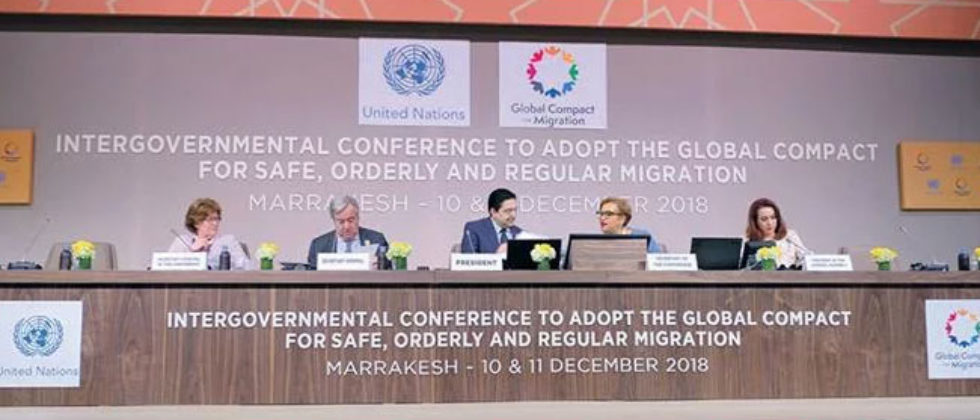news
“The United Nations Global Migration Compact”, an article by Dr. Leonel Fernández
January 3, 2019
Last week in Morocco the United Nations Member States approved the Global Compact for Safe, Orderly and Regular Migration, an initiative promoted by the United Nations Organization.
The pact calls for, among other objectives, the strengthening of cooperation systems on international migration; the creation of common goals; shared responsibilities and unit of purpose in all areas that have to do with the immigration phenomenon, by far one of the most transcendent global issues in the early 21st century.
However, in of spite its passing, the pact received very weak support from the Member States, which is what usually occurs in this sort of debate on global agreements.
Of the 193 Member States, only 164 signed the pact. Twenty-nine did not sign, including, fortunately, the Dominican Republic.
This, however, seems quite strange. It is bizarre because since July of this year, after 18 months of inter-governmental negotiation processes, all the U.N.-member nations approved the document that would serve as a foundation for its final approval in Morocco of the abovementioned migration pact.
The interest behind the promotion of a global pact to establish principals and values related to international migration processes was a consequence of the serious immigration crisis that impacted several European nations in 2015. That year, the number of irregular migrants that arrived on the coasts of the Old Continent reached 645,000.
Of course, this situation was the result of the impact that the global financial crisis generated and which finally exploded in 2008. To date, a definitive solution has not been found.
In addition to the financial crisis, a massive wave of immigrants moved to several European nations as a result of the devastating circumstances provoked by the Arab Spring, especially in countries such as Syria and Libya.
The number of individuals that tried to escape the bloody civil war was immense. Thousands crossed over to Greece, Turkey and Italy. In a generous act of solidarity, which was accompanied by high political cost, Germany’s Chancellor, Angela Merkel, opened the doors of her country to more than 1.4 million refugees.
Thousands upon thousands of young men and women – disoriented and battered by poverty – traveled in fragile makeshift boats from Sub-Saharan Africa to the Mediterranean Sea. Their only goal was to seek new horizons that would give their lives some sense of meaning. During their journey, however, some found death along the way.
As a consequence of this grave immigration crisis in Europe, the authorities determined to establish an inter-governmental dialogue that could establish guidelines and protocols for safe, orderly and regular immigration processes.
This situation led the way to the approval, by the United Nations General Assembly in 2016, of the New York Declaration for Refugees and Migrants. The Declaration served as a framework for the inter-governmental negotiation process that concluded last week, with the approval of the Global Migration Pact in Morocco.
ON THE ROAD TO MOROCCO
Although, as stated previously, 192 U.N. Member States approved the pact this past July, only 164 nations approved the document in Morocco.
Why did the voting turn out this way? Why, even though the pact does not have legal enforceability or obligations, did countries that had originally voted in favor of the Pact in July disapprove of its adoption in December?
For some countries, the main reason was that the application of norms and immigration policies is the sole responsibility of the Member States. Therefore, by signing the pact – and according to its criteria – the Member States would lose some of their sovereign rights on this issue.
But, the truth is that the pact does support the sovereign rights of the states to establish its own immigration norms and policies. It precisely “reaffirms the sovereign right of States to determine their national migration policy and their prerogative to govern migration within their jurisdiction, in conformity with international law.”
Therefore, what led certain countries to be concerned with the sovereignty concept is not so much the fact that it was not included in the text of the agreement. It was due to the ambiguity or ambivalence derived from the language used in other parts of the document. In this context, political and moral commitments are established that would limit the rights of the sovereign state.
For example, for the United States the migration agreement is inconsistent and incompatible with its immigration and refugee policies. Also, it violates freedom of expression and the standards established to detain immigrants. It promotes an unreal access to local social services.
For Australia, the pact does not adequately distinguish between individuals who enter the country legally and those that enter the country irregularly.
All this coincides with the situation in Slovakia, which argued that the economic and security risks generated by illegal immigration were not taken into consideration.
In Israel, the government understood that the pact weakened the country’s capacity to protect its borders against illegals that had entered the country.
Austria believed that the document would impact its sovereignty and the country’s capacity to decide its own immigration policies.
For Bulgaria, which is an important immigration route between the Middle East and Western Europe, the immigration pact did not protect the interests of the country or of its citizens.
In the case of Chile, the government expressed that immigration is not a human right; and that – on quite the contrary – nations have the right to determine entrance requirements for foreigners.
THE DOMINICAN CASE
The Dominican Republic, on the other hand, is no stranger to this debate. In fact, just a few days prior to the inter-governmental conference in Morocco, the Dominican government, after the presentation of a report by an inter-institutional commission, and in tune with the adverse reactions expressed by various national sectors, decided that the country would withdraw from the Conference and not sign the Global Migration Pact.
The Dominican government explained, among other reasons, that its decision to not sign the document is due to its unique condition of sharing an island with a nation that has very different economic, social, environmental and security conditions than its own.
Another reason is because of the possible weakening of the state when it comes to the implementation of norms and immigration policies.
Likewise, the government explained that the pact would generate commitments that would limit the capacity of the state to respond to situations that could take place along the country’s border region.
Aside from the arguments presented by the Dominican government, and although the pact includes clauses that recognizes universal principles for the protection of human rights, it also contains additional dispositions that could negatively impact national interests.
The first of these are the clauses that provide migrants, independent of their immigration status, access to all basic services.
This of course would mean accepting unexpected obligations that are currently not considered in international law. It would also mean undertaking expenses that would surpass financial capacity. This would mean that the Dominican State would not be able to meet the responsibilities it has with its own nationals and legal immigrants.
Secondly, the immigrant pact establishes the detention of irregular migrants as a last resource, making the application of internal norms and the eventual deportation to their country of origin impossible.
Thirdly, the requirement to “facilitate access for migrants in an irregular status to an individual assessment that may lead to regular status, on a case by case basis…” would be equivalent to a sort of permanent plan to regulate foreigners.
And, finally, the United Nations agreement proposes to “develop or build on existing national and regional practices for admission and stay of appropriate duration on compassionate, humanitarian or other considerations for migrants compelled to leave their countries of origin, due to sudden-onset natural disasters and other precarious situation.”
Based on this criteria, there is no clear difference between the refugee, the humanitarian migrant and the one that abandons their country for economic reasons, which would imply a non-differentiated assimilation of all kinds of migrants.
On the other hand, there are concerns regarding the implications for the country’s image that could emanate from follow-up procedures and verification of the pact, as suggested be done periodically.
Although the Global Compact for Safe, Orderly and Regular Migration was conceived with the intention of regulating a global phenomenon of great transcendence, it did not foresee the different realities that various countries, or parts of the world, are experiencing.
That is the case of the Dominican Republic, which, even though is understanding of the importance of the global attempts being made to regulate the immigration phenomenon, could not accept some of the agreement’s principles since they could be harmful to national interests.
For these reasons the Dominican government decided not to adhere to the Global Compact for Safe, Orderly and Regular Migration.






